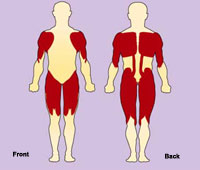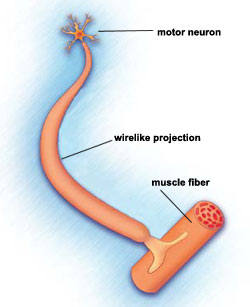|
|
Therefore6
we do not lose heart.
Even though
our outward man is perishing,
yet the
inward man is being renewed day by day.
For our
light affliction, which is but for a moment,
is working
for us a far more exceeding and eternal weight of glory,
while we
do not look at the things which are seen,
but at
the things which are not seen.
For the
things which are seen are temporary,
but the
things which are not seen are eternal.
2 Corinthians
4:16-18
|
|
| In 1954 only eight months
after my older brother Bernie was born, my parents received the devastating
news that he had Spinal Muscular Atrophy. A little more than two
years later, I was born with the same disease and four years following
my diagnosis, my sister Tina, the fourth child in a family of seven was
also diagnosed with the same illness.
Spinal Muscular Atrophy (SMA) is
a genetic disease affecting the part of the nervous system that controls
voluntary muscle movement.
Most of the nerve cells that control
muscles are located in the spinal cord, which accounts for the word spinal
in the name of the disease. SMA is muscular, because its primary effect
is on muscles, which don�t receive signals from these nerve cells. Atrophy
is the medical term for wasting or shrinkage, which is what generally happens
to muscles when they�re not active.
SMA involves the loss of nerve cells
called motor neurons in the spinal cord and is classified as a motor neuron
disease.
Most cases of SMA are caused by a
deficiency of a motor neuron protein called SMN, for survival of motor
neurons.
This protein, as its name implies,
seems to be necessary for normal motor neuron function. Recent evidence
suggests that a lack of SMN might also directly affect muscle cells.
There�s a great deal of variation
in the scope and severity of SMA in different people. My brother,
sister and myself have Type 1 SMA otherwise known as (Werdnig-Hoffmann
Disease)
Children with SMA who are very weak
in the early months of life and have breathing, sucking and swallowing
difficulties in infancy aren�t likely to have a good prognosis. In the
past, it was said that such children weren�t likely to survive more than
two years. Today, this is still often true.
However, with technology to take
the place of natural breathing and eating functions, such children can
often survive several years. Mechanical ventilation (today�s ventilators
are portable, in contrast to the "iron lungs" and heavy machinery of former
decades) and feeding tubes that go directly into the stomach (not down
the throat) can prolong life.
Mental and emotional development
and sensation are entirely normal in SMA.
Many children with SMA can benefit
greatly from physical therapy and assistive technology.
Though being bedridden for the past
several years, by the grace of God, Bernie and I have overcome the odds
and live productive and happy lives. In God's all-wise providence,
my sister Tina died just before reaching age four from this illness.
Please remember my family in your
prayers, as we seek to glorify God in our circumstances. |

|
| The
muscles closer to the center of the body (proximal muscles) are usually
more affected in spinal muscular atrophy than are the muscles farther from
the center (distal muscles). |
|

|
| Muscle-controlling
nerve cells (motor neurons) are located mostly in the spinal cord. Long,
wirelike projections connect the motor neurons to muscles in the limbs
and trunk. Normally, signals from the neurons to the muscles cause muscles
to contract. In SMA, motor neurons are lost, and muscles can�t function. |
|
Disability
Links
|
|
|

|
|
Purchase
Here
|
|
|
|